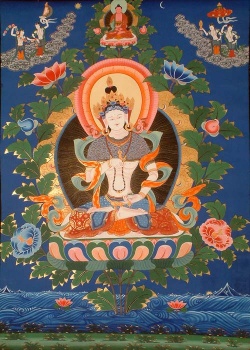Difference between revisions of "Amala consciousness"
| Line 4: | Line 4: | ||
[阿摩羅識] (Skt [[amala-vijnana]]; Jpn [[amara-shiki]] ) | [阿摩羅識] (Skt [[amala-vijnana]]; Jpn [[amara-shiki]] ) | ||
| − | Also, [[free-of-defilement consciousness]] or [[pure consciousness]]. The ninth and deepest of the [[nine consciousnesses]]. ''Amala'' means {{Wiki|pure}} or {{Wiki|undefiled}}, and [[vijnana]] means [[discernment]]. The [[eight consciousnesses]] set forth in the [[Consciousness-Only]] [[doctrine]] consist of the [[six consciousnesses]] (discernment by {{Wiki|eyes}}, {{Wiki|ears}}, {{Wiki|nose}}, {{Wiki|tongue}}, {{Wiki|body}}, and [[mind]]), the [[mano consciousness]], and the [[alaya -consciousness]]. To these the [[Summary of the Mahayana]] (Chin [[Shelun]]; Jpn [[Shoron]]) school founded by [[Paramartha]] (499-569), the [[Flower Garland]] ([[Hua-yen]]; [[Kegon]]) school founded by [[Tu-shun]] (557-640), and the [[T'ient'ai]] ( Jpn [[Tendai]]) school added a [[ninth consciousness]], which is defined as the basis of all of [[life]]'s functions. While the eighth, or [[alaya -consciousness]] contains [[karmic]] {{Wiki|impurities}}, the [[amala consciousness]] is {{Wiki|pure}}, free from all {{Wiki|defilement}}, and corresponds to the [[Buddha nature]]. | + | Also, [[free-of-defilement consciousness]] or [[pure consciousness]]. The ninth and deepest of the [[nine consciousnesses]]. ''[[Amala]]'' means {{Wiki|pure}} or {{Wiki|undefiled}}, and [[vijnana]] means [[discernment]]. The [[eight consciousnesses]] set forth in the [[Consciousness-Only]] [[doctrine]] consist of the [[six consciousnesses]] ([[discernment]] by {{Wiki|eyes}}, {{Wiki|ears}}, {{Wiki|nose}}, {{Wiki|tongue}}, {{Wiki|body}}, and [[mind]]), the [[mano consciousness]], and the [[alaya -consciousness]]. To these the [[Summary of the Mahayana]] (Chin [[Shelun]]; Jpn [[Shoron]]) school founded by [[Paramartha]] (499-569), the [[Flower Garland]] ([[Hua-yen]]; [[Kegon]]) school founded by [[Tu-shun]] (557-640), and the [[T'ient'ai]] ( Jpn [[Tendai]]) school added a [[ninth consciousness]], which is defined as the [[basis of all]] of [[life]]'s functions. While the eighth, or [[alaya -consciousness]] contains [[karmic]] {{Wiki|impurities}}, the [[amala consciousness]] is {{Wiki|pure}}, free from all {{Wiki|defilement}}, and corresponds to the [[Buddha nature]]. |
The ‘[[unsullied consciousness]]’, a term used in [[Paramārtha]]'s system of [[Yogācāra]] and equivalent in many respects to [[Buddha-nature]] or the [[tathāgata-garbha]]. | The ‘[[unsullied consciousness]]’, a term used in [[Paramārtha]]'s system of [[Yogācāra]] and equivalent in many respects to [[Buddha-nature]] or the [[tathāgata-garbha]]. | ||
Revision as of 16:17, 29 August 2013
amala-consciousness
[阿摩羅識] (Skt amala-vijnana; Jpn amara-shiki )
Also, free-of-defilement consciousness or pure consciousness. The ninth and deepest of the nine consciousnesses. Amala means pure or undefiled, and vijnana means discernment. The eight consciousnesses set forth in the Consciousness-Only doctrine consist of the six consciousnesses (discernment by eyes, ears, nose, tongue, body, and mind), the mano consciousness, and the alaya -consciousness. To these the Summary of the Mahayana (Chin Shelun; Jpn Shoron) school founded by Paramartha (499-569), the Flower Garland (Hua-yen; Kegon) school founded by Tu-shun (557-640), and the T'ient'ai ( Jpn Tendai) school added a ninth consciousness, which is defined as the basis of all of life's functions. While the eighth, or alaya -consciousness contains karmic impurities, the amala consciousness is pure, free from all defilement, and corresponds to the Buddha nature.
The ‘unsullied consciousness’, a term used in Paramārtha's system of Yogācāra and equivalent in many respects to Buddha-nature or the tathāgata-garbha.
See also; nine consciousnesses.
